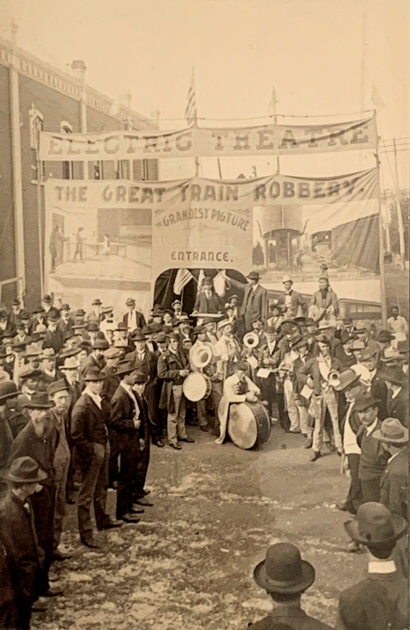
The Great Train Robbery
Original Photograph of the Seminal Film's Ad Campaign
1903
Offers
Shipping $99 Standard Parcel View Options
Questions about this piece
Item Details:
THE GREAT TRAIN ROBBERY
THOMAS EDISON
GOLDEN AGE OF SILENT CINEMA, 1903
Important Original Advertising Campaign Documentation Scene Photograph
Publisher: unknown
Wet-plate Collodion Cabinet Card
Size: 4.3 x 7.44 in; 10.92 x 18.9 cm
Signed: unsigned
The present work is an important photographic document of the advertising campaign in real-time for this seminal American film. Showing a mostly-male crowd gathered around the outdoor scene, complete with musicians, a sideshow-type barker at the entryway of a darkened proto-movie theatre, surrounded by room-size hand-painted canvas banners, alongside a wooden stage with the costumed characters of Uncle Sam and a Native American, this important photograph illustrates the uniquely American over-the-top sensationalist exploitation practice, connecting the circus, theatre, visual art, music (recognized as especially-necessary for a silent film), and patriotism, all combined here under the command and choreography of snake-oil salesmanship. The Great Train Robbery is a 1903 American silent film made by Edwin S. Porter for the Edison Manufacturing Company. It follows a gang of outlaws who hold up and rob a steam locomotive at a station in the American West, flee across mountainous terrain, and are finally defeated by a posse of locals. Porter supervised and photographed the film in New York and New Jersey in November 1903; the Edison studio began selling it to vaudeville houses and other venues in the following month. A special close-up shot, which was unconnected to the story and could either begin or end the film depending on the projectionist's whim, showed Barnes, as the outlaw leader, emptying his gun directly into the camera.
Private Collection
Creator: unknown
Creation Year: 1903
Dimensions: 4.3 x 7.44 in
Medium: Wet-plate Collodion Cabinet Card
Movement/Style: Golden Age Of Silent Cinema
Period: Historic Early Cinema
Condition: Very Good
